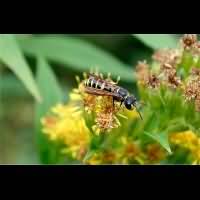Sand Tailed Digger Wasp Cerceris arenaria
The Sand Tailed Digger Wasp is the biggest Cerceris species in Britain. There is remarkable little difference in size between males and females, for males reach a length of 9 to 15mm, females grow to a length of 11 to 16mm. Females can be identified by looking at their bottom, which is broader in this species than in other Cerceris species. And using a magnifying glass one may even be able to identify the males. They have a few very long hairs on the last segment of the antenna. Besides they are often bigger than the males of other Cerceris species. Still telling the males of Cerceris species apart is a very tricky thing!
The Sand Tailed Digger Wasp will begin flying about in May. It prefers dry, firm, sandy soils. The female will dig a tunnel, some 40cm deep. To the sides she'll construct a few cells. Each cell is provided with some 5 to 12 paralyzed animals of prey for the larvae: weevils usually, but leaf beetles are hunted for as well. Sand Tailed Digger Wasps may settle in colonies of well over 100 animals per square meter, but strictly solitary nests are found as frequently. This species is often found in villages and even big city centres, where is builds nests between tiles and using terraces.
A common species over much of Britain, except for the far north. A very common species on the continent as well. Probably because it is that common, it has quite some parasitic 'friends'. Among those are two species of Cuckoo Wasps, various species of Flesh Flies, some cleptoparasitic Metopia flies and even some species of Root-maggot Flies.
The Sand Tailed Digger Wasp is the biggest Cerceris species in Britain. There is remarkable little difference in size between males and females, for males reach a length of 9 to 15mm, females grow to a length of 11 to 16mm. Females can be identified by looking at their bottom, which is broader in this species than in other Cerceris species. And using a magnifying glass one may even be able to identify the males. They have a few very long hairs on the last segment of the antenna. Besides they are often bigger than the males of other Cerceris species. Still telling the males of Cerceris species apart is a very tricky thing!
The Sand Tailed Digger Wasp will begin flying about in May. It prefers dry, firm, sandy soils. The female will dig a tunnel, some 40cm deep. To the sides she'll construct a few cells. Each cell is provided with some 5 to 12 paralyzed animals of prey for the larvae: weevils usually, but leaf beetles are hunted for as well. Sand Tailed Digger Wasps may settle in colonies of well over 100 animals per square meter, but strictly solitary nests are found as frequently. This species is often found in villages and even big city centres, where is builds nests between tiles and using terraces.
A common species over much of Britain, except for the far north. A very common species on the continent as well. Probably because it is that common, it has quite some parasitic 'friends'. Among those are two species of Cuckoo Wasps, various species of Flesh Flies, some cleptoparasitic Metopia flies and even some species of Root-maggot Flies.




